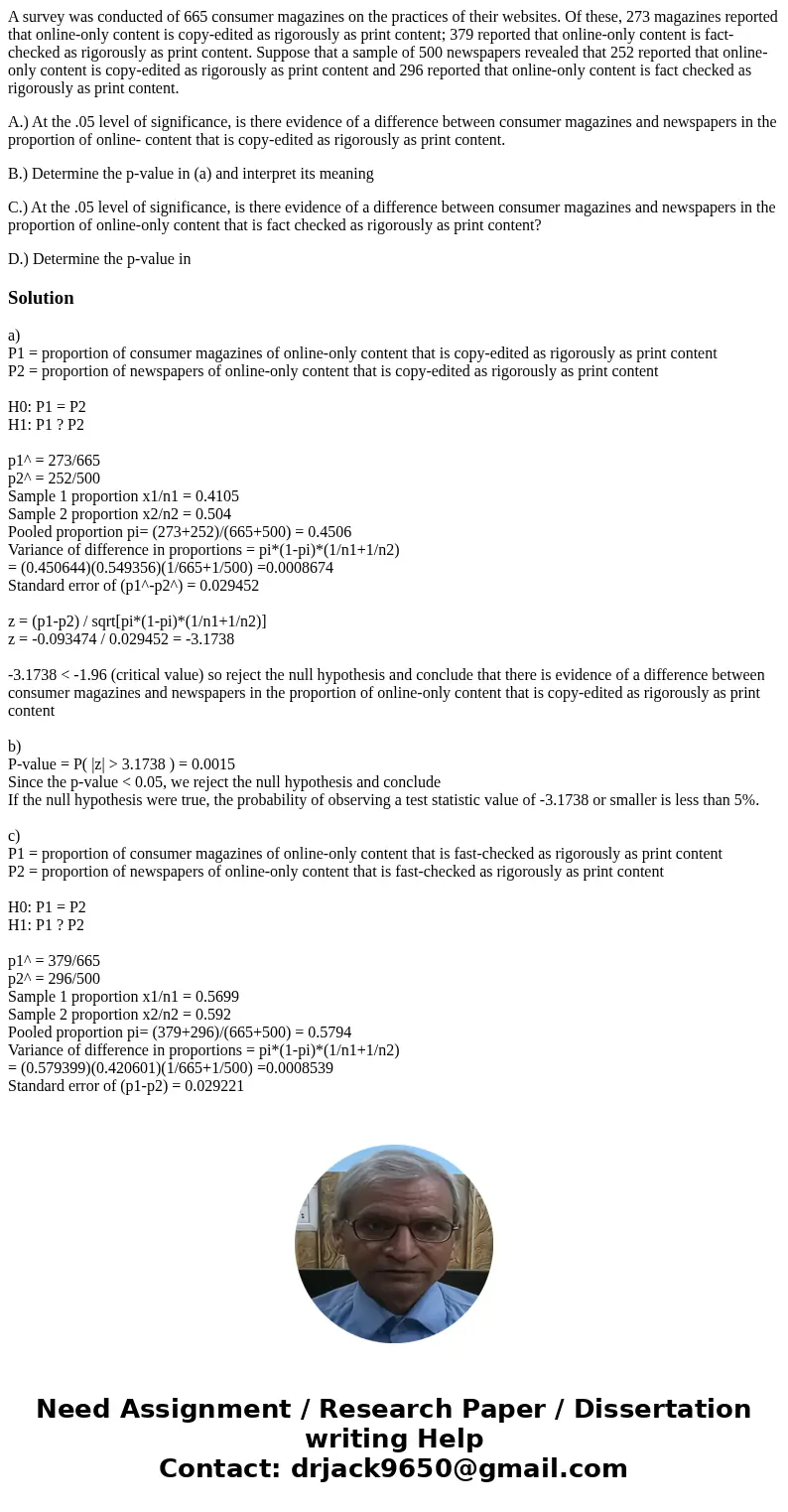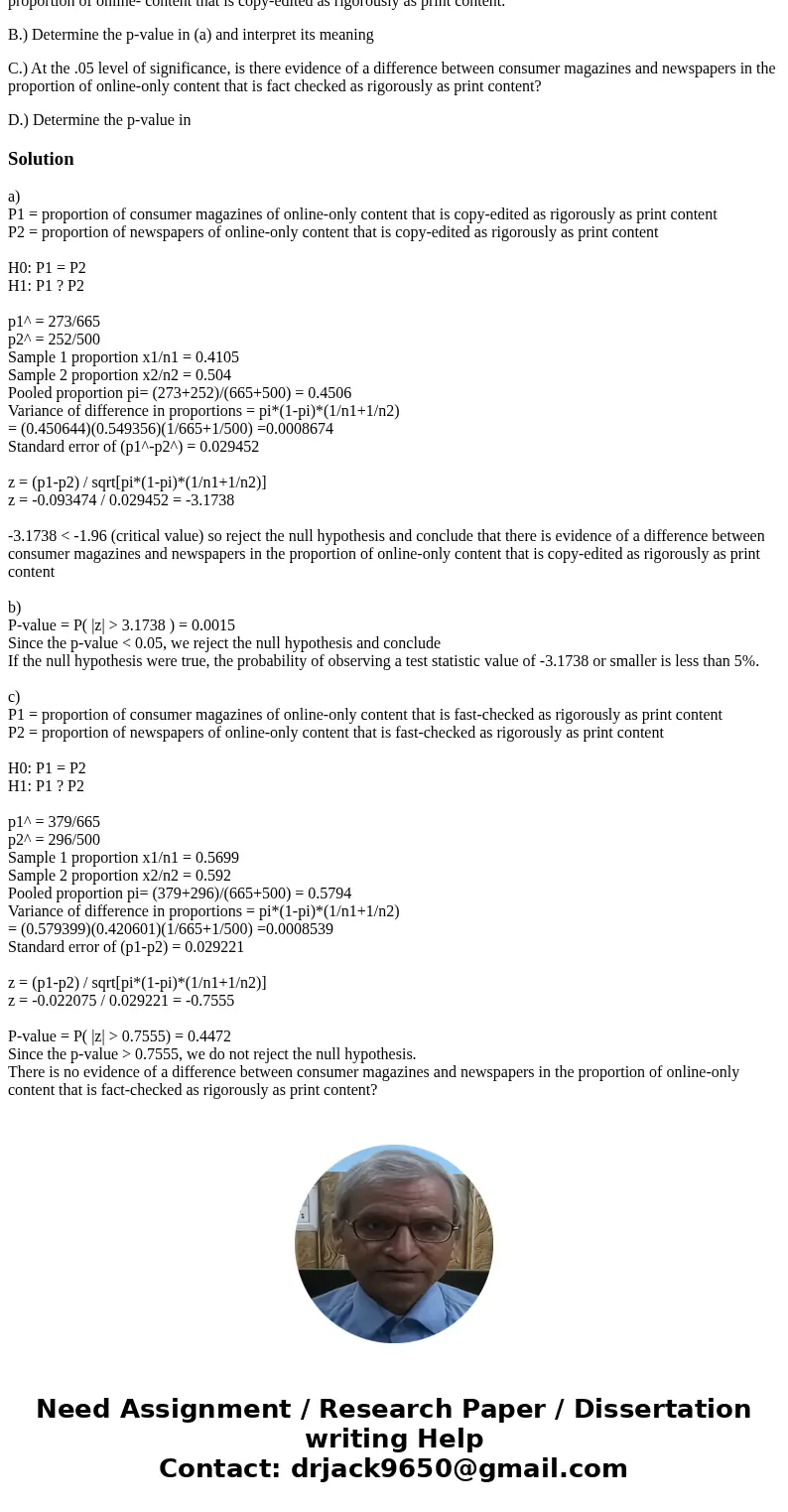A survey was conducted of 665 consumer magazines on the prac
A survey was conducted of 665 consumer magazines on the practices of their websites. Of these, 273 magazines reported that online-only content is copy-edited as rigorously as print content; 379 reported that online-only content is fact-checked as rigorously as print content. Suppose that a sample of 500 newspapers revealed that 252 reported that online-only content is copy-edited as rigorously as print content and 296 reported that online-only content is fact checked as rigorously as print content.
A.) At the .05 level of significance, is there evidence of a difference between consumer magazines and newspapers in the proportion of online- content that is copy-edited as rigorously as print content.
B.) Determine the p-value in (a) and interpret its meaning
C.) At the .05 level of significance, is there evidence of a difference between consumer magazines and newspapers in the proportion of online-only content that is fact checked as rigorously as print content?
D.) Determine the p-value in
Solution
a)
P1 = proportion of consumer magazines of online-only content that is copy-edited as rigorously as print content
P2 = proportion of newspapers of online-only content that is copy-edited as rigorously as print content
H0: P1 = P2
H1: P1 ? P2
p1^ = 273/665
p2^ = 252/500
Sample 1 proportion x1/n1 = 0.4105
Sample 2 proportion x2/n2 = 0.504
Pooled proportion pi= (273+252)/(665+500) = 0.4506
Variance of difference in proportions = pi*(1-pi)*(1/n1+1/n2)
= (0.450644)(0.549356)(1/665+1/500) =0.0008674
Standard error of (p1^-p2^) = 0.029452
z = (p1-p2) / sqrt[pi*(1-pi)*(1/n1+1/n2)]
z = -0.093474 / 0.029452 = -3.1738
-3.1738 < -1.96 (critical value) so reject the null hypothesis and conclude that there is evidence of a difference between consumer magazines and newspapers in the proportion of online-only content that is copy-edited as rigorously as print content
b)
P-value = P( |z| > 3.1738 ) = 0.0015
Since the p-value < 0.05, we reject the null hypothesis and conclude
If the null hypothesis were true, the probability of observing a test statistic value of -3.1738 or smaller is less than 5%.
c)
P1 = proportion of consumer magazines of online-only content that is fast-checked as rigorously as print content
P2 = proportion of newspapers of online-only content that is fast-checked as rigorously as print content
H0: P1 = P2
H1: P1 ? P2
p1^ = 379/665
p2^ = 296/500
Sample 1 proportion x1/n1 = 0.5699
Sample 2 proportion x2/n2 = 0.592
Pooled proportion pi= (379+296)/(665+500) = 0.5794
Variance of difference in proportions = pi*(1-pi)*(1/n1+1/n2)
= (0.579399)(0.420601)(1/665+1/500) =0.0008539
Standard error of (p1-p2) = 0.029221
z = (p1-p2) / sqrt[pi*(1-pi)*(1/n1+1/n2)]
z = -0.022075 / 0.029221 = -0.7555
P-value = P( |z| > 0.7555) = 0.4472
Since the p-value > 0.7555, we do not reject the null hypothesis.
There is no evidence of a difference between consumer magazines and newspapers in the proportion of online-only content that is fact-checked as rigorously as print content?


 Homework Sourse
Homework Sourse